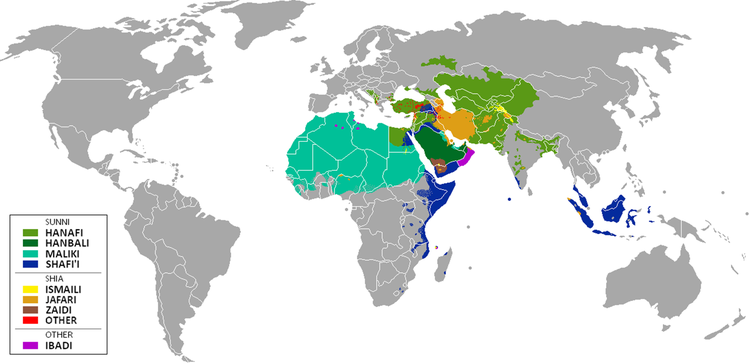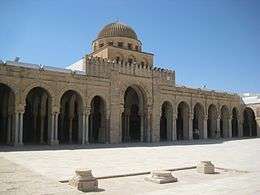Maliki
The Mālikī (Arabic: مَالِكِي) school is one of the four major madhhabs of Islamic jurisprudence within Sunni Islam.[1] It was founded by Malik ibn Anas in the 8th century. The Maliki school of jurisprudence relies on the Quran and hadiths as primary sources. Unlike other Islamic fiqhs, Maliki fiqh also considers the consensus of the people of Medina to be a valid source of Islamic law.[2]
| Part of a series on |
| Sunni Islam |
|---|
 |
In terms of Ihsan |
|
|
|
Lists |
|
|
The Maliki madhhab is one of the largest groups of Sunni Muslims, comparable to the Shafi`i madhhab in adherents, but smaller than the Hanafi madhhab.[3][4] Sharia based on Maliki doctrine is predominantly found in North Africa (excluding northern and eastern Egypt), West Africa, Chad, Sudan, Kuwait, Bahrain,[5] the Emirate of Dubai (UAE), and in northeastern parts of Saudi Arabia.[3]
In the medieval era, the Maliki school was also found in parts of Europe under Islamic rule, particularly Islamic Spain and the Emirate of Sicily.[6] A major historical center of Maliki teaching, from the 9th to 11th centuries, was in the Mosque of Uqba of Tunisia.[7][8]
History

Although Malik ibn Anas was himself a native of Medina, his school faced fierce competition for followers in the Muslim east, with the Shafi'i, Hanbali, and Zahiri schools all enjoying more success than Malik's school.[9] It was eventually the Hanafi school, however, that earned official government favor from the Abbasids.
Imam Malik (who was a teacher of Imam Ash-Shafi‘i,[10][11]:121 who in turn was a teacher of Imam Ahmad ibn Hanbal) was a Shi'ite Imam Ja'far (a descendant of the Islamic Nabi (Prophet) Muhammad), as with Imam Abu Hanifah. Thus all of the four great Imams of Sunni Fiqh are connected to Ja'far, whether directly or indirectly.[12]
The Malikis enjoyed considerably more success in Africa, and for a while in Spain and Sicily. Under the Umayyads and their remnants, the Maliki school was promoted as the official state code of law, and Maliki judges had free rein over religious practices; in return, the Malikis were expected to support and legitimize the government's right to power.[13] This dominance in Spanish Andalus from the Umayyads up to the Almoravids continued, with Islamic law in the region dominated by the opinions of Malik and his students. The Sunnah and Hadith, or prophetic tradition in Islam, played lesser roles as Maliki jurists viewed both with suspicion, and few were well versed in either.[14] The Almoravids eventually gave way to the predominantly-Zahiri Almohads, at which point Malikis were tolerated at times but lost official favor. With the Reconquista, the Iberian Peninsula was lost to the Muslims in totality.
Although Al-Andalus was eventually lost, the Maliki has been able to retain its dominance throughout North and West Africa to this day. Additionally, the school has traditionally been the preferred school in the small Arab States of the Persian Gulf (Bahrain, Kuwait and Qatar).[15] While the majority of the United Arab Emirates and Saudi Arabia follows Hanbali laws, the country's Eastern Province has been known as a Maliki stronghold for centuries.[3]
Principles
Maliki school's sources for Sharia are hierarchically prioritized as follows: Quran and then trustworthy Hadiths (sayings, customs and actions of Muhammad); if these sources were ambiguous on an issue, then `Amal (customs and practices of the people of Medina), followed by consensus of the Sahabah (the companions of Muhammad), then individual's opinion from the Sahabah, Qiyas (analogy), Istislah (interest and welfare of Islam and Muslims), and finally Urf (custom of people throughout the Muslim world if it did not contradict the hierarchically higher sources of Sharia).[1]
The Mālikī school primarily derives from the work of Malik ibn Anas, particularly the Muwatta Imam Malik, also known as Al-Muwatta. The Muwaṭṭa relies on Sahih Hadiths, includes Malik ibn Anas' commentary, but it is so complete that it is considered in Maliki school to be a sound hadith in itself.[2] Mālik included the practices of the people of Medina and where the practices are in compliance with or in variance with the hadiths reported. This is because Mālik regarded the practices of Medina (the first three generations) to be a superior proof of the "living" sunnah than isolated, although sound, hadiths. Mālik was particularly scrupulous about authenticating his sources when he did appeal to them, however, and his comparatively small collection of aḥādith, known as al-Muwaṭṭah (or, The Straight Path).[2]
The second source, the Al-Mudawwana, is the collaborator work of Mālik's longtime student, Ibn Qāsim and his mujtahid student, Sahnun. The Mudawwanah consists of the notes of Ibn Qāsim from his sessions of learning with Mālik and answers to legal questions raised by Saḥnūn in which Ibn Qāsim quotes from Mālik, and where no notes existed, his own legal reasoning based upon the principles he learned from Mālik. These two books, i.e. the Muwaṭṭah and Mudawwanah, along with other primary books taken from other prominent students of Mālik, would find their way into the Mukhtaṣar Khalīl, which would form the basis for the later Mālikī madhhab.
Maliki school is most closely related to the Hanafi school, and the difference between them is more of a degree, rather than nature.[17] However, unlike the Hanafi school, the Maliki school does not assign as much weight to analogy, but derives its rulings from pragmatism using the principles of istislah (public interest) wherever the Quran and Sahih Hadiths do not provide explicit guidance.[17]
Notable differences from other schools
The Maliki school differs from the other Sunni schools of law most notably in the sources it uses for derivation of rulings. Like all Sunni schools of Sharia, the Maliki school uses the Qur'an as primary source, followed by the sayings, customs/traditions and practices of Muhammad, transmitted as hadiths. In the Mālikī school, said tradition includes not only what was recorded in hadiths, but also the legal rulings of the four rightly guided caliphs – especially Umar.
Malik bin Anas himself also accepted binding consensus and analogical reasoning along with the majority of Sunni jurists, though with conditions. Consensus was only accepted as a valid source of law if it was drawn from the first generation of Muslims in general, or the first, second or third generations from Medina, while analogy was only accepted as valid as a last resort when an answer was not found in other sources.[18][19]
Notable Mālikīs
- Ibn Abd al-Hakam (d. 829), one of the Egyptian scholars who developed the Maliki school in Egypt [20]
- Asbagh ibn al-Faraj (d. 840), Egyptian scholar [21]
- Yahya al-Laithi (d. 848), Andalusian scholar, introduced the Maliki school in Al-Andalus
- Sahnun (AH 160/776–77 – AH 240/854–55), Sunnī jurist and author of the Mudawwanah, one of the most important works in Mālikī law
- Abd al-Malik ibn Habīb (AH 174/790-241/853), a prominent student of the direct students of Imām Mālik. He collected the opinions of Imām Mālik and his students in his al-Wādiḥah, which is one of the most important works in Mālikī law and the main authoritative book on Mālikī law in al-Andalus and the Maghrib.
- Ibn Abi Zayd (310/922–386/996), Tunisian Sunnī jurist and author of the Risālah, a standard work in Mālikī law
- Yusuf ibn abd al-Barr (978–1071), Andalusian scholar
- Ibn Tashfin (1061–1106), one of the prominent leaders of the Almoravid dynasty
- Ibn Rushd (Averroes) (1126–1198), philosopher and scholar
- Al-Qurtubi (1214–1273)
- Shihab al-Din al-Qarafi (1228–1285), Moroccan jurist and author who lived in Egypt
- Khalil ibn Ishaq al-Jundi (d. ca. 1365), Egyptian jurist, author of Mukhtasar
- Ibn Battuta (February 24, 1304 – 1377), explorer
- Ibn Khaldūn (1332/AH 732–1406/AH 808), scholar, historian and author of the Muqaddimah
- Abu Ishaq al-Shatibi (d. 1388), a famous Andalusian Maliki jurist
- Qadi Iyad
Contemporary Malikis
- Usman dan Fodio (1754–1817), founder of the Sokoto Caliphate
- El Hadj Umar Tall (1794–1864), founder of the Toucouleur Empire
- Emir Abdelkader (1808–1883), Algerian sufi and politician, religious and military leader who led a struggle against the French colonial invasion
- Ahmad al-Alawi (1869–1934), Algerian Sufi leader
- Omar Mukhtar (1862–1931), Libyan resistance leader
- Abdallah Bin Bayyah (1935) Mauritania professor of Islamic in King AbdulAziz university Jedda
- Muhammad Ibn 'Abd al-Karim al-Khattabi, Moroccan resistance leader.
- Abu-Abdullah Adelabu
- Sherman Jackson
- Salâh Ud Dîn At Tijânî
- Hamza Yusuf
- Suhaib Webb
See also
- Outline of Islam
- Glossary of Islam
- List of Islamic scholars
- The Seven Fuqaha of Medina
- Adhan
- Islamic views on sin
References
- Ramadan, Hisham M. (2006). Understanding Islamic Law: From Classical to Contemporary. Rowman Altamira. pp. 26–27. ISBN 978-0-7591-0991-9.
- Vincent J. Cornell (2006), Voices of Islam, ISBN 978-0275987336, pp 160
- Jurisprudence and Law – Islam Reorienting the Veil, University of North Carolina (2009)
- Abdullah Saeed (2008), The Qur'an: An Introduction, Routledge, ISBN 978-0415421256, pp. 16–18
- "International Religious Freedom (2000)".
- Bernard Lewis (2001), The Muslim Discovery of Europe, WW Norton, ISBN 978-0393321654, p. 67
- Wilfrid Scawen Blunt and Riad Nourallah, The future of Islam, Routledge, 2002, page 199
- Ira Marvin Lapidus, A history of Islamic societies, Cambridge University Press, 2002, page 308
- Camilla Adang, This Day I have Perfected Your Religion For You: A Zahiri Conception of Religious Authority, pg. 17. Taken from Speaking for Islam: Religious Authorities in Muslim Societies. Ed. Gudrun Krämer and Sabine Schmidtke. Leiden: Brill Publishers, 2006.
- Dutton, Yasin, The Origins of Islamic Law: The Qurʼan, the Muwaṭṭaʼ and Madinan ʻAmal, p. 16
- Haddad, Gibril F. (2007). The Four Imams and Their Schools. London, the U.K.: Muslim Academic Trust. pp. 121–194.
- "Imam Ja'afar as Sadiq". History of Islam. Archived from the original on 2015-07-21. Retrieved 2012-11-27.
- Maribel Fierro, Proto-Malikis, Malikis and Reformed Malikis in al-Andalus, pg. 61. Taken from The Islamic School of Law: Evolution, Devolution and Progress. Eds. Peri Bearman, Rudolph Peters and Frank E. Vogel. Cambridge, Massachusetts, 2005.
- Fierro, "The Introduction of Hadith in al-Andalus (2nd/8th - 3rd/9th centuries)," pg. 68–93. Der Islam, vol. 66, 1989.
- Saudi Arabia and the Gulf Arab States Today. Retrieved 8 February 2020.
- Roland Anthony Oliver and Anthony Atmore, Medieval Africa, 1250–1800, Cambridge University Press, 2001, page 36
- Jamal Nasir (1990), The Islamic Law of Personal Status, Brill Academic, ISBN 978-1853332807, pp. 16–17
- Mansoor Moaddel, Islamic Modernism, Nationalism, and Fundamentalism: Episode and Discourse, pg. 32. Chicago: University of Chicago Press, 2005.
- Reuben Levy, Introduction to the Sociology of Islam, pg. 237, 239 and 245. London: Williams and Norgate, 1931–1933.
- Brockopp, Jonathan E. (2000-01-01). Early Mālikī Law: Ibn ʻAbd Al-Ḥakam and His Major Compendium of Jurisprudence. BRILL. ISBN 978-90-04-11628-3.
- Tillier, Mathieu; Vanthieghem, Naïm (2019-09-13). "Un traité de droit mālikite égyptien redécouvert : Aṣbaġ b. al-Faraǧ (m. 225/ 840) et le serment d'abstinence". Islamic Law and Society. 26 (4): 329–373. doi:10.1163/15685195-00264P01. ISSN 0928-9380.
Further reading
- Cilardo, Agostino (2014), Maliki Fiqh, in Muhammad in History, Thought, and Culture: An Encyclopedia of the Prophet of God (2 vols.), Edited by C. Fitzpatrick and A. Walker, Santa Barbara, ABC-CLIO
- Chouki El Hamel (2012), Slavery in Maliki School in the Maghreb, in Black Morocco: A History of Slavery, Race, and Islam, Cambridge University Press, ISBN 978-1107025776
- Thomas Eich (2009), Induced Miscarriage (Abortion) in Early Maliki and Hanafi Fiqh, Islamic Law & Society, Vol. 16, pp. 302–336
- Janina Safran (2003), Rules of purity and confessional boundaries: Maliki debates about the pollution of the Christian, History of religions, Vol. 42 No. 3, pp. 197–212
- FH Ruxton (1913), The Convert's Status in Maliki Law, The Muslim World, Vol 3, Issue 1, pp. 37–40, doi:10.1111/j.1478-1913.1913.tb00174.x
External links
- Partial Translation of Mālik's Al-Muwaṭṭah University of Southern California
- Malikiyyah Bulend Shanay, Lancaster University
- Biographical summary of Imam Mālik
- Al-Risalah of 'Abdullah ibn Abi Zayd al-Qayrawani 10th century Maliki text on Islamic law, Translated by Aisha Bewley
- French translations of a variety of important Mālikī source texts (in French)
